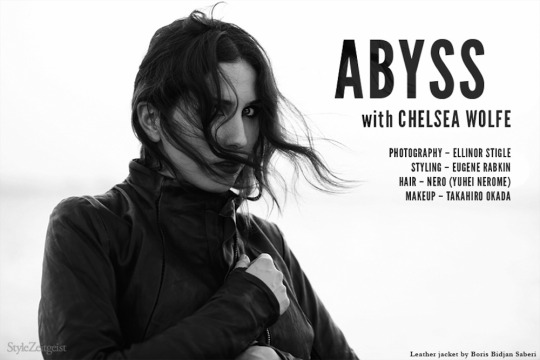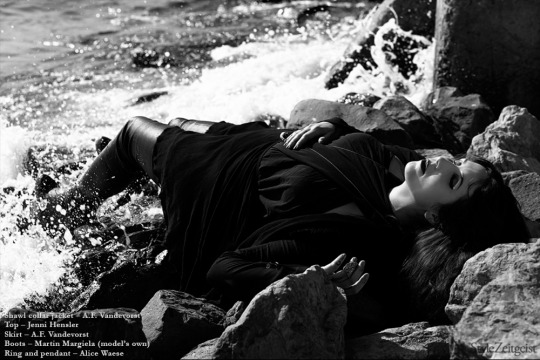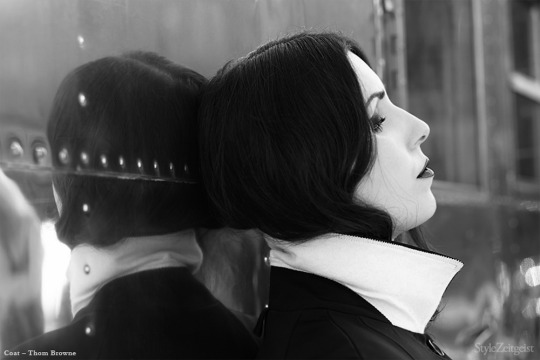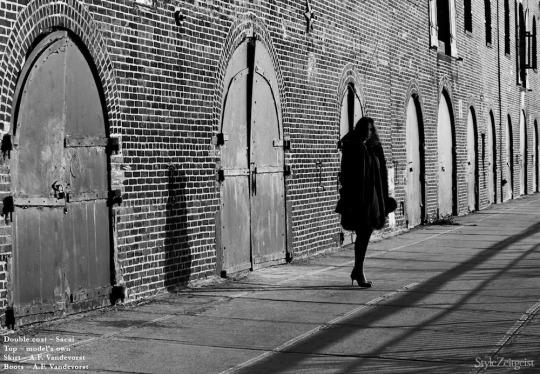

Interview by Eugene Rabkin
See full photoshoot by StyleZeitGeist HERE
I first met the singer Chelsea Wolfe at an understatedly swank, dimly lit bar in downtown Los Angeles a year ago. The place looked newly minted and was completely empty. Over drinks and small bites Wolfe and her collaborator Ben Chisholm, talked about their work and life in the desert (they recently moved outside of LA). Wolfe’s forth studio album, “Pain Is Beauty,” came out the year before. It was well received by critics and has found her a new audience. Unrelenting, Wolfe was already working on a new album, “Abyss.”
We kept in touch as Wolfe recorded and finally reunited when she was in New York on the Abyss tour. We spent the first day shooting in Brooklyn’s Red Hook; the next day we met in the lobby of her decidedly unglamorous Brooklyn hotel.
“Abyss” might be Wolfe’s most challenging record yet. While “Pain Is Beauty” was dark, it was not hard to digest. The distortion was kept to a palatable level and the vibrant percussion and strings gave the album energy without it sounding assaulting.
On some songs on the new album, however, the guitar distortion tests the listener’s endurance. It recalled The Swans finest moments of aural limit pushing, and I was not surprised to learn that the album was produced by John Congleton, who has worked with The Swans in the past. Wolfe confessed that even she was not sure she did the right thing when she heard the final version of the record.
And yet, virtually all music that I have come to love is difficult; it has both attractive and repulsive qualities. After taking the time to internalize the difficult parts of a particular album that would become a favorite, I would come to love it that much more. With repeated listenings of “Abyss” (accompanied by murder threats from those I’ve subjected to it in my car and in my house), the record’s intricacies have slowly appeared like an image that gradually takes shape on photographic paper.

The central unifying force of Wolfe’s music is her stunning voice that can reach significant depths. It is routinely described as “haunting,” as is Wolfe’s music, but this moniker, as does pigeonholing Wolfe as “goth,” misses something more significant and relevant – a kind of strength that is essential to Wolfe’s body of work that has to do with acknowledging the world’s dark side without wallowing in it or distorting it to comic-strip fantasy levels.
Undoubtedly, Wolfe’s subject matter is for the most part bleak. “Pain Is Beauty,” dealt with natural disasters and “Abyss” with people in her life that had committed suicide. “I just tend to be drawn to characters and situations that are based in reality, but they happen to be on the heavier side,” Wolfe told me.
“I really think it’s something that’s always been there with me,” she continued. “Even when I started writing poems as a kid, they were on the dark side. One of the first poems I remember writing was because I heard an ambulance go by, and it clicked with me that that it is going to help someone who’s probably just had a car accident and was on the ground bleeding. I was putting all these connections together and realizing that it really wasn’t just my life, but I was part of this greater world, where so many different things are happening all at the same time. Sometimes, I think if you could hear all of the sounds in the world, all the laughter and all of the crying, and all of the voices at the same time, it would just be so totally overwhelming. That’s always been an inspiration.”
As the flip side of darkness is light, so it is with Wolfe. “I think I’m an idealist at heart, and I’d like to believe that people can be good,” she said. “I write a lot about overcoming things and fighting on. That’s important, too, to not give in to the darkness. I try and be an idealist most of the time, but the world just drags you right back down.”

Wolfe began making music when she was a kid. Her father was in a band and had a home studio where Wolfe got to tinker when she visited him on weekends after her parents divorced. She started writing poetry when she was six, and her child dream was to become a poet, until it dawned on her that she could put words to music. Wolfe asked her father to teach her how to use the Tascam 8-track and a Casio keyboard he had, and she began making songs. She also taught herself to play the guitar and her music output became consistent.
But Wolfe’s biggest obstacle to sharing her deeply personal music was her shyness. “When it came to showing my music to people, I just never felt it was good enough,” she said. Gradually, Wolfe’s friends and family convinced her to play in public. At first, stage fright got the better of her. Even though Wolfe recorded an album in her early 20s, she did not feel it was good enough and canned the record. Wolfe took a break from music until the performance artist Steve Vanoni invited her to be the resident musician on a performance artist tour in Europe. She quit her job and left. She was 24.
On that tour Wolfe found encouragement for the first time. “People who are into performance art are usually very open and accepting of anything, so I felt like I could just be myself,” she said. “So I just tested out songs. Sometimes I did acoustics; sometimes I would borrow an electric guitar and some pedals, and I would sing through pedals and experiment otherwise. That really guided my sound and I felt like I had finally found the way I like to sing.”
Upon returning home Wolfe immediately began working on her first album, “The Grime and the Glow,” which she released in December of 2010. Since, then, Wolfe’s rise in popularity has been steady in her comparatively short music career.

Wolfe’s band has also had an influence on the style of “Abyss.” She began her career appearing on stage solo, but having a band gave her a new range of possibilities. “I want to maximize the fact that I have this great band,” Wolfe said. “I really want to write and play heavy songs, so I kind of ditched the more minimal songs I’ve been writing and started focusing on the heavier stuff, heavier guitars. Obviously, subject-wise it’s pretty heavy, too, so that kind of guided it. A lot of the initial inspiration for the new record being heavier was knowing that I was going to continue to tour, and I wanted to have songs that would translate well live. It can be enjoyable to do the acoustic stuff, too, but I’ve done an acoustic tour before. Last year, opening for the Eels, I had a really hard time with it. I didn’t feel like I was ready to be up there alone in that quiet state, so I started gearing towards the heavier stuff, mostly for the live set.”
The next night I attended Wolfe’s concert at the Music Hall of Williamsburg, and I got to see exactly what she was talking about. The live band gave new musical meaning to the album. Wolfe’s formidable vocal range, Ben Chisholm’s prolific guitar and keyboard skills, and the awe-inspiring percussion of Dylan Fujioka left the audience in thrall.
Another reason for having a band is that it takes attention off of Wolfe on stage. Even though she has gotten over her stage fright, Wolfe feels more comfortable sharing the stage, despite remaining its centerpiece. And while she likes touring, in the ideal world she would rather stay at home and make music.
“I really have to prepare myself to go on tour: mentally, physically, and emotionally,” Wolfe told me. “Even just packing, finding the right things because you can’t bring your whole life on tour, so you have to pair it down to a favorite group of outfits and things like that.”
“But then when I’m out on the road I’m kind of okay with it. The van becomes your home. The venues become your home. You just sort of roll with the punches and it starts to become a really cool routine. You get to go to a new city everyday and meet new people everyday. It’s mostly when we get tired that we don’t like touring. There are weeks where you don’t get any sleep and everyone starts to bare their teeth a little bit.”

Wolfe’s style is the direct extension of her music and her personality. She works closely with her stylist Jenni Hensler, who makes custom pieces for Wolfe, which she mixes with designer fashion. Unsurprisingly, she counts the cerebral, rock-n-roll influenced designers like Ann Demeulemeester, Rick Owens, A.F. Vandevorst, Yohji Yamamoto, and Martin Margiela among her favorites.
Her fascination with style partly came out of her initial stage fright and the desire to hide herself, to simultaneously be present and absent. “At first I was so nervous to even get on stage that my tactic to deal with it was to wear long, black dresses. I wore a lace black veil on stage for the first three years, because I really couldn’t handle the fact that I was up in front of everyone with all these eyes looking.”
She still picks clothes that make her feel protected. “When you’re a performer you really have to put yourself together and make yourself strong in order to go out there on stage and let yourself fall apart. Because if you’re uncomfortable in the first place, you are not going to have a good show, and you are not going to really let yourself go and give yourself to the audience. But if you feel protected by that Ann Demeulemeester jacket, you’re going to have a really good show.”